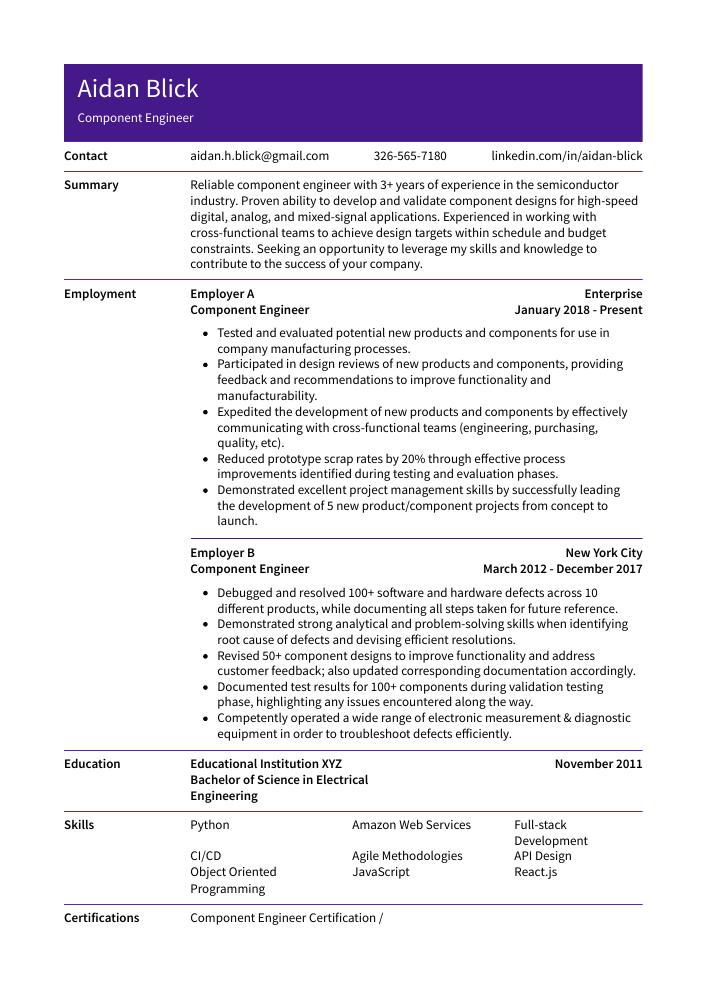Component Engineer Resume Guide
Component Engineers design, develop and test the components that make up larger systems. They are responsible for ensuring that all components meet safety standards, performance requirements and customer specifications. They also work to troubleshoot any issues with existing components or systems in order to improve their efficiency and reliability.
Your expertise in component engineering makes you a valuable asset to any company. To get the attention of potential employers, it’s essential that you write an impressive resume that highlights your qualifications and experience.
This guide will walk you through the entire process of creating a top-notch resume. We first show you a complete example and then break down what each resume section should look like.
Table of Contents
The guide is divided into sections for your convenience. You can read it from beginning to end or use the table of contents below to jump to a specific part.
Component Engineer Resume Sample
Darwin Hirthe
Component Engineer
[email protected]
936-806-4842
linkedin.com/in/darwin-hirthe
Summary
Reliable component engineer with 5+ years of experience in the automotive industry. Proven track record for designing and developing components from concept to production, providing cost-effective solutions that meet customer specifications. Experienced in working closely with engineering teams to ensure design accuracy while meeting deadlines. Skilled at managing multiple projects simultaneously and troubleshooting technical issues quickly and efficiently.
Experience
Component Engineer, Employer A
Laredo, Jan 2018 – Present
- Assembled, tested and evaluated a variety of components for electronic systems, leading to the successful completion of over 200 projects within budget.
- Documented component assembly processes using technical drawings, ensuring that all procedures were followed accurately; reduced error rate by 15%.
- Reorganized component inventory system which resulted in an increase in productivity by 20% and improved delivery times for customer orders.
- Represented engineering team at project meetings with clients; successfully negotiated contracts worth $5 million across various industries such as automotive, aerospace and medical devices manufacturing sectors.
- Effectively managed up to 10 junior engineers while meeting tight deadlines on multiple projects simultaneously; supervised installation process of 500+ components without any safety incidents or delays in production schedule.
Component Engineer, Employer B
Orlando, Mar 2012 – Dec 2017
- Utilized CAD software, creating and maintaining detailed designs of components to ensure compliance with design specifications; improved component accuracy by 15%.
- Spearheaded the development of three new components that reduced manufacturing costs by 8%, while improving product durability and reliability.
- Advised a team of 10 engineers on best practices for testing, analyzing and debugging prototype parts; raised efficiency levels across the board by 20%.
- Upgraded existing production lines with more advanced fabrication systems, saving up to $50k in manual labor costs within 6 months.
- Actively monitored performance metrics for all active products under my watch; identified 3 issues before they affected customers’ experience, resulting in 25% fewer complaints from users over an 18 month period.
Skills
- Circuit Design
- PCB Layout
- Soldering
- Electrical Engineering
- Analog and Digital Circuit Design
- Microcontroller Programming
- Embedded Systems
- Power Electronics
- Robotics
Education
Bachelor of Science in Electrical Engineering
Educational Institution XYZ
Nov 2011
Certifications
Certified Component Engineer (CCE)
Institute for Component Engineering
May 2017
1. Summary / Objective
Your resume summary should provide a snapshot of your skills and experience as a component engineer. In this section, you can highlight the components you have designed in the past, any certifications or awards that demonstrate your expertise, and how you have successfully collaborated with other engineers to solve complex problems. This is an opportunity for you to showcase why employers should hire you over other candidates.
Below are some resume summary examples:
Well-rounded component engineer with 5+ years of experience developing, testing, and optimizing components for consumer electronics. Eager to join ABC Tech to help create innovative products that meet customer needs while adhering to safety standards. At XYZ, identified potential design flaws in new product prototypes which improved reliability by 41%. Proven ability to work independently as well as collaboratively within teams.
Passionate component engineer with 8+ years of experience designing, developing, and testing electronic components. Experienced in both analog and digital circuits. At XYZ company, designed a high-performance component that reduced the time to market by 6 months while also increasing efficiency by 30%. Skilled at troubleshooting complex issues related to component design and integrating new technology into existing systems.
Amicable and adaptable Component Engineer with 5+ years of experience developing functional components for a wide range of products. Looking to join ABC Tech and use my expertise in the design, development, testing, and implementation of complex mechanical systems. In previous roles I have reduced product cycle times by 40%, improved component reliability by 50%, and decreased scrap material costs by 20%.
Hard-working component engineer with 5+ years of experience in the design, development and testing of complex components. Highly experienced in working closely with customers to discuss their requirements and develop innovative solutions that meet their needs. Proven track record of success leading projects from concept through completion, resulting in improved efficiency and cost savings for clients.
Accomplished component engineer with over 10 years of experience in designing, developing, and debugging components for a variety of products. Consistently identified ways to improve component designs while minimizing costs. At XYZ Company, developed cost-effective solutions that improved product reliability by 20%. Proven ability to manage multiple projects simultaneously while meeting deadlines.
Determined Component Engineer with 5+ years of experience designing, testing and troubleshooting complex machinery components. Seeking to join ABC Company in order to develop innovative solutions that will improve the performance, safety, and reliability of products. Proven track record of successfully creating cost-effective designs and reducing production times by up to 25%.
Proficient component engineer with 6+ years of experience designing and developing complex components for a range of industries. Seeking to join ABC Technologies as the next Component Engineer, leveraging expertise in problem-solving and troubleshooting hardware issues. At XYZ, reduced component failure rate by 20%, saving the company $200K annually in repairs.
Seasoned component engineer with 7+ years of experience developing and testing electronic components. Proven success in troubleshooting, editing schematics, and debugging components for a variety of consumer electronics applications. Seeking to bring expertise to ABC Electronics as the next Component Engineer to support their cutting-edge products.
2. Experience / Employment
For the experience section, start with your most recent job and list the other roles in reverse chronological order. Stick to bullet points when writing this section, as it makes it easier for the reader to digest what you want to convey.
When describing each role, provide detail on what you did and any results that were achieved. For example, instead of saying “Developed components,” say something like “Designed 30+ custom-made components per week using CAD software; improved component efficiency by 10%.”
To write effective bullet points, begin with a strong verb or adverb. Industry specific verbs to use are:
- Designed
- Fabricated
- Assembled
- Installed
- Programmed
- Calibrated
- Troubleshot
- Optimized
- Tested
- Debugged
- Documented
- Analyzed
- Researched
- Monitored
- Upgraded
Other general verbs you can use are:
- Achieved
- Advised
- Assessed
- Compiled
- Coordinated
- Demonstrated
- Developed
- Expedited
- Facilitated
- Formulated
- Improved
- Introduced
- Mentored
- Participated
- Prepared
- Presented
- Reduced
- Reorganized
- Represented
- Revised
- Spearheaded
- Streamlined
- Structured
- Utilized
Below are some example bullet points:
- Designed and developed various electronic components for new products, resulting in a 39% increase in product efficiency.
- Presented complex technical specifications to the engineering team and higher-level management; secured approval from stakeholders on 3 major projects within tight deadlines.
- Independently researched and tested innovative materials that could be used as alternatives to existing components, leading to cost savings of over $7,000 annually.
- Analyzed data collected during testing phases of component development process and identified areas for improvement; decreased return rate by 15%.
- Assessed potential suppliers according to quality standards before making any purchases; sourced high-quality parts at competitive prices while reducing total procurement time by 20%.
- Formulated and implemented innovative engineering solutions to improve existing components and develop new ones, resulting in an 18% reduction in production costs.
- Programmed automated testing systems for all newly designed components, ensuring that quality standards were met before deployment; updated code libraries with the latest revisions over a 6 month period.
- Optimized programming and debugging processes by introducing cutting-edge technologies, reducing development time of commercial products by 27%.
- Confidently diagnosed issues related to component structures or circuitry while troubleshooting customer complaints within 2 hours on average; resolved 95+ problems per quarter without external assistance from other departments or vendors.
- Debugged hardware prototypes during field testing using advanced evaluation tools and techniques, successfully detecting defects at early stages of product design which saved $15K in rework expenses annually.
- Mentored 3 junior engineers in the design, assembly and testing of electronic components including transistors, resistors and capacitors; improved overall team performance by 35%.
- Expedited component manufacturing process by designing innovative jigs to reduce production time from 15 minutes per unit to 10 minutes – resulting in a cost savings of $9,000 over 3 months.
- Monitored product quality during assembly phase for up to 2 weeks at a time; identified defects quickly and handled them efficiently with minimal disruption to operations schedule.
- Meticulously documented all changes made on drawings using CAD software such as AutoCAD & SolidWorks while adhering strictly to industry standards across 8+ projects spanning 6 months period.
- Researched new technologies that could be used in the development of advanced components, leading an initiative which resulted in 20% increase in efficiency compared with existing models within 3 months timeframe.
- Diligently designed and tested over 600 components for new products; reduced development costs by 8% while increasing product reliability.
- Streamlined manufacturing processes by revising existing component designs to improve efficiency, resulting in a 20% reduction in production time per unit.
- Revised CAD drawings, assembly instructions and procedures to ensure accuracy of all components before delivery; improved quality assurance metrics by 25%.
- Installed automated testing equipment at critical stages of the production process to detect defects early on; increased detection rate from 40-60%.
- Reduced downtime due to faulty parts or incorrect installation procedures by introducing more stringent regulations on suppliers and personnel training programs for installers/maintainers of the components.
- Introduced new components to the engineering process, resulting in an improvement of 25% in production efficiency.
- Participated actively in system integration, testing and debugging processes for new components; ensured that all specifications were met within a 10-hour time frame on average.
- Prepared technical reports detailing component evaluation metrics such as performance, reliability and cost; reduced overall material costs by 15%.
- Efficiently managed the inventory of parts and supplies needed to develop various electrical/mechanical systems without any delays or wastage issues; achieved 99% order accuracy rate over 6 months period.
- Structured detailed plans outlining step-by-step procedures for engineers when working with different types of components across multiple platforms; improved quality assurance levels by 20%.
- Calibrated and tested components in accordance with specified criteria using specialized equipment; improved accuracy of measurements by 80% and shortened calibration times from 3 hours to 1 hour.
- Troubleshot complex component issues, performing detailed root cause analysis and identifying potential solutions that resulted in a 20% reduction in system downtime.
- Facilitated the integration of new components into existing systems without disrupting production cycles or compromising quality; saved $6,000 on labor costs within 6 months of deployment.
- Successfully led cross-functional teams through all phases of development for five electrical/mechanical components which were delivered ahead schedule per customer specifications & requirements at less than half the budgeted cost expectations.
- Compiled reports outlining project progress, testing results and recommended modifications as needed; reduced report writing time by 35%.
- Coordinated the development and assembly of over 200 components per month, ensuring that design specifications were met while staying within budget.
- Achieved a cost reduction of 20% through the introduction of innovative new components and optimization of existing designs.
- Developed 4 new component prototypes in 8 weeks, successfully meeting customer requirements for speed and accuracy in production cycle times.
- Resourcefully identified potential issues with current designs using CAD software to perform virtual simulations which resulted in a 15% decrease in defects during product testing phase compared to previous year’s results.
- Tested all newly developed components according to industry standards; approved 95% of parts on first inspection leading to increased efficiency gains across supply chain operations by 50%.
- Demonstrated advanced proficiency in designing, testing and troubleshooting various components of electrical systems; improved product quality by 33% through the implementation of upgraded production methods.
- Improved overall system performance by 15%, resulting in a reduction of maintenance costs for clients over time.
- Fabricated circuit boards and other prototype parts to customer specifications with close attention to detail; achieved zero defects or errors at the end-stage manufacturing level consistently each week.
- Consistently updated engineering data records throughout entire design process while conforming to safety protocols set out by company standards; decreased accidents on factory floor by 6%.
3. Skills
Two organizations that have advertised for a position with the same title may be searching for individuals whose skills are quite different. For instance, one may be looking for a component engineer with experience in designing and testing electronic components, while another is seeking someone who has expertise in creating mechanical parts.
Therefore, it’s important to tailor the skills section of your resume to each job that you are applying for. This can easily be done by taking note of the requirements specified in the job posting and then highlighting those same abilities on your CV.
It is also essential to mention these qualifications elsewhere on your resume – such as within the summary or experience sections – so that they stand out more clearly when employers scan through applications using applicant tracking systems (computer programs designed specifically to search resumes).
Below is a list of common skills & terms:
- Analog and Digital Circuit Design
- Automation
- Circuit Design
- Electrical Engineering
- Embedded Systems
- Microcontroller Programming
- PCB Layout
- Power Electronics
- Robotics
- Soldering
4. Education
Including an education section on your resume will depend on how far you are into your career. If you just graduated and have no prior experience, include the details of your educational background below your resume objective. However, if you have significant work experience that should be showcased first, it is perfectly acceptable to omit an education section altogether.
If including an education section, try to mention courses or subjects relevant to the component engineer role for which you are applying.
Bachelor of Science in Electrical Engineering
Educational Institution XYZ
Nov 2011
5. Certifications
Certifications are a great way to demonstrate your expertise and proficiency in a particular field. They can be used to prove that you have the skills necessary for the job, as well as show potential employers that you are committed to staying up-to-date with industry trends.
Include any certifications relevant to the position on your resume so hiring managers know exactly what qualifications you possess. This will help them determine if you are qualified for the role or not.
Certified Component Engineer (CCE)
Institute for Component Engineering
May 2017
6. Contact Info
Your name should be the first thing a reader sees when viewing your resume, so ensure its positioning is prominent. Your phone number should be written in the most commonly used format in your country/city/state, and your email address should be professional.
You can also choose to include a link to your LinkedIn profile, personal website, or other online platforms relevant to your industry.
Finally, name your resume file appropriately to help hiring managers; for Darwin Hirthe, this would be Darwin-Hirthe-resume.pdf or Darwin-Hirthe-resume.docx.
7. Cover Letter
Submitting a cover letter with your resume gives you the opportunity to elaborate on key points in your CV and make a lasting impression. This document usually consists of 2-4 paragraphs that explain why you are an ideal candidate for the position, what makes you stand out from other applicants and why employers should hire you.
Cover letters are not always necessary when applying for jobs but they can be extremely helpful if written properly. They provide recruiters with more information about who you are as a person, allowing them to get a better understanding of how well suited you’d be for the role at hand.
Below is an example cover letter:
Dear Michel,
I am writing to apply for the Component Engineer position at ABC Corporation. With more than 10 years of experience in component engineering and a strong background in electronics, I am confident I can be an asset to your team.
At XYZ Inc., where I have worked for the past five years, I have been responsible for designing and testing electronic components for a variety of products. My experience has given me a deep understanding of how components work together to form larger systems, and I have gained valuable experience troubleshooting issues that arise during the design process. In addition, I have developed a keen eye for detail that allows me to spot potential problems early on and prevent them from becoming costly mistakes later on.
I believe my skills and experience would make me a valuable asset to your team. In particular, my ability to design high-quality components quickly and efficiently would be beneficial in meeting deadlines and ensuring customer satisfaction. Moreover, my attention to detail would help ensure that all products meet the highest standards of quality before being released to market.
If you are interested in learning more about my qualifications or if you would like discuss this opportunity further, please do not hesitate contact me at [phone number] or [email address]. Thank you for your time and consideration; I look forward hearing from you soon!
Sincerely,
Darwin
Component Engineer Resume Templates
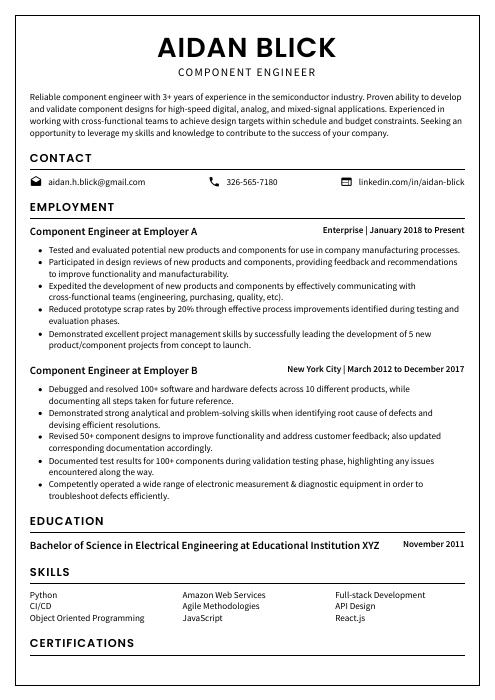 Cormorant
Cormorant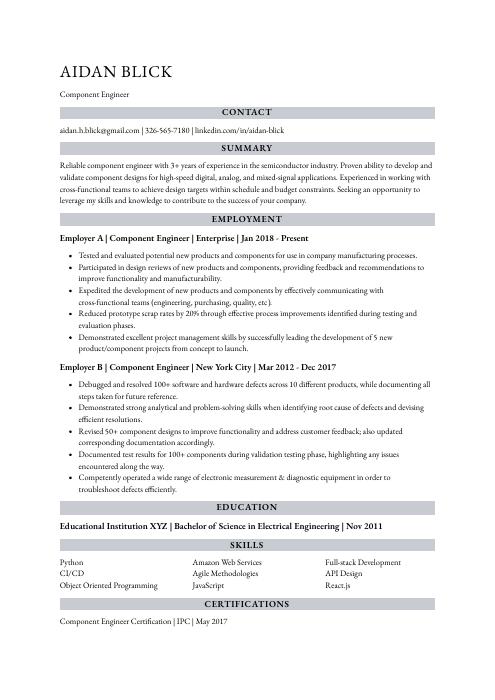 Numbat
Numbat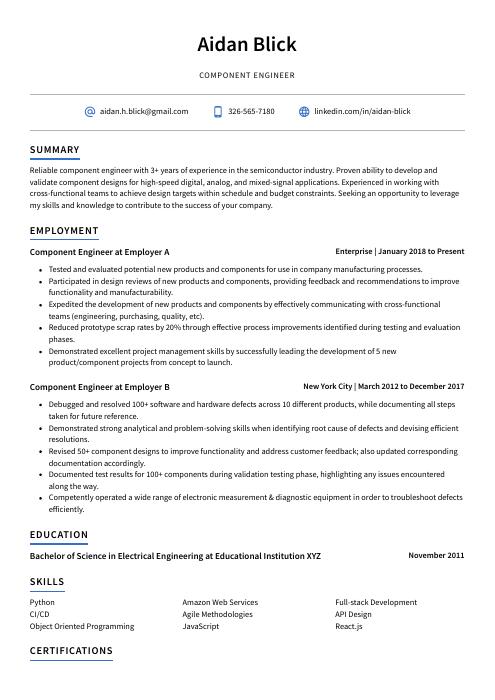 Axolotl
Axolotl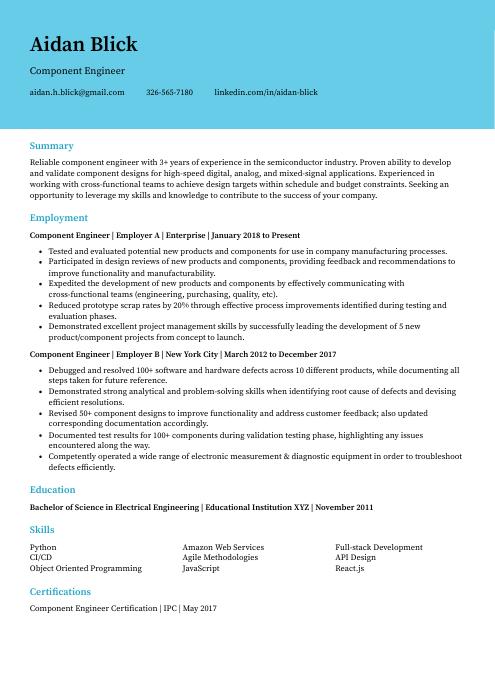 Dugong
Dugong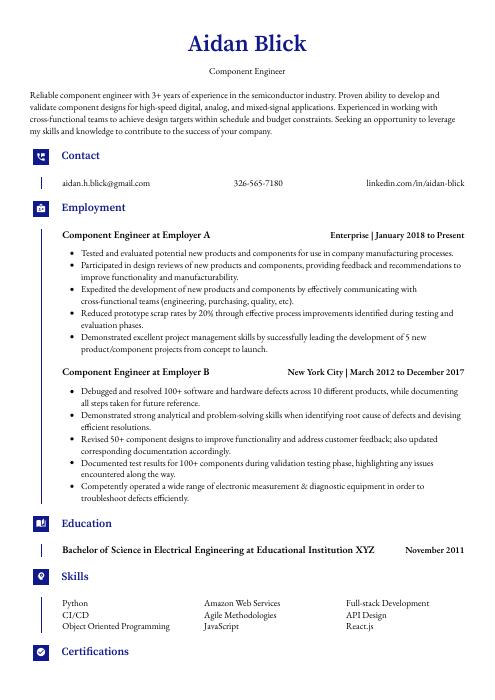 Gharial
Gharial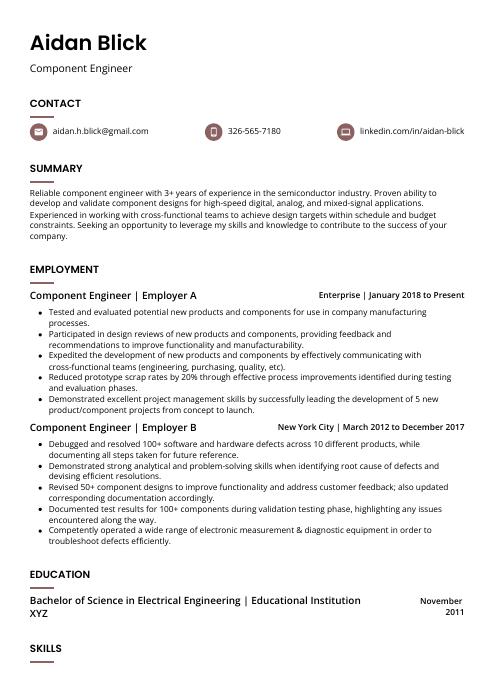 Fossa
Fossa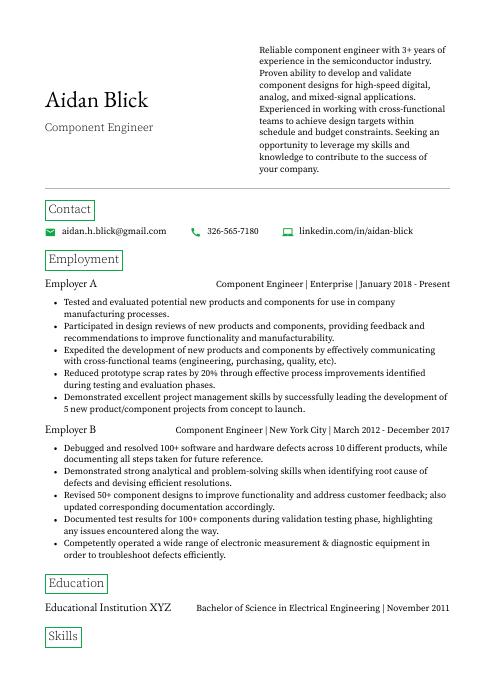 Quokka
Quokka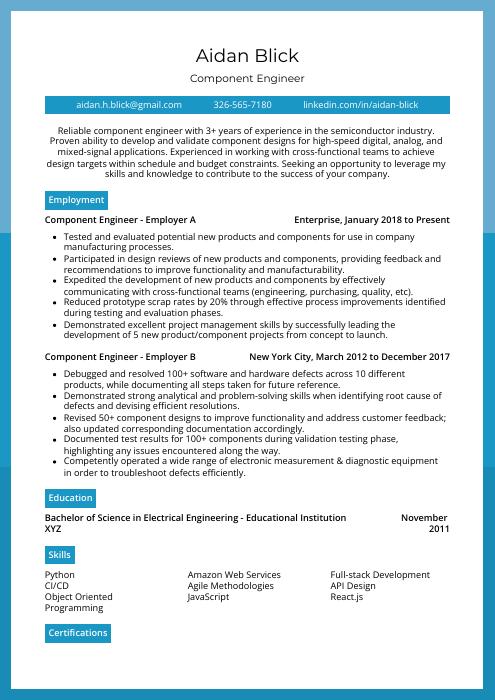 Rhea
Rhea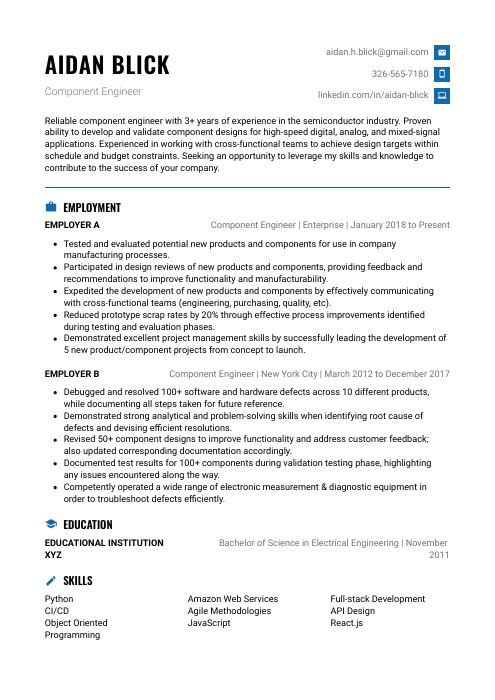 Echidna
Echidna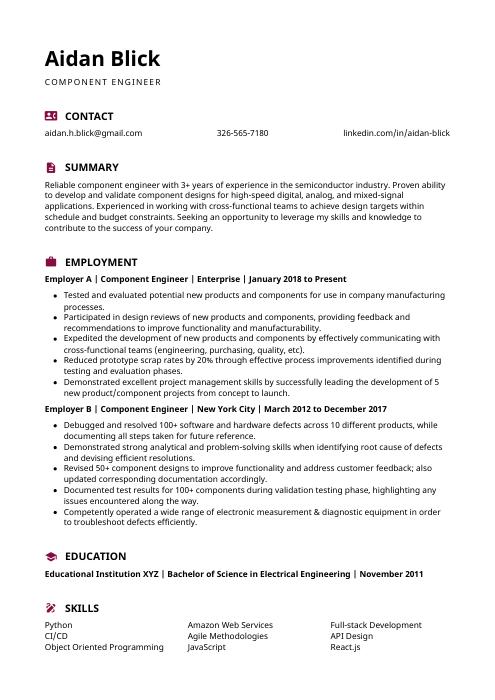 Hoopoe
Hoopoe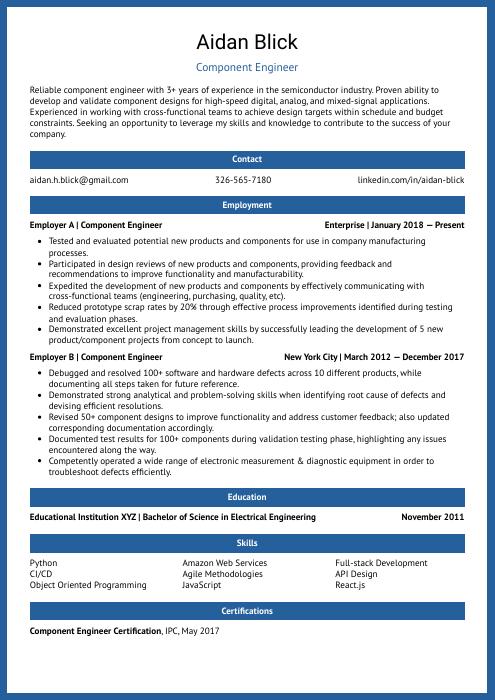 Ocelot
Ocelot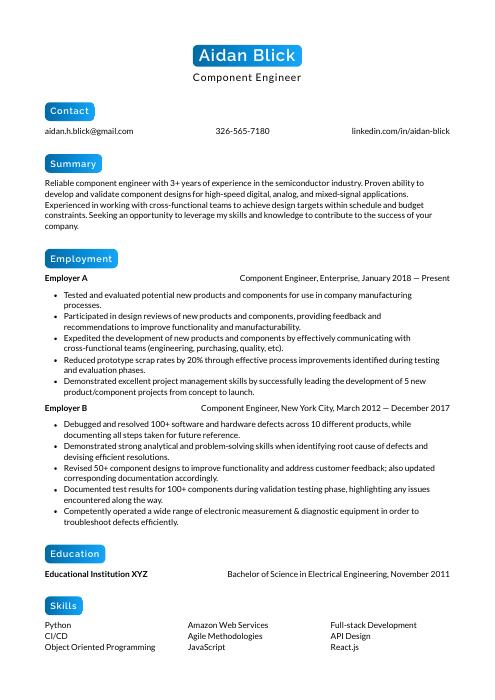 Kinkajou
Kinkajou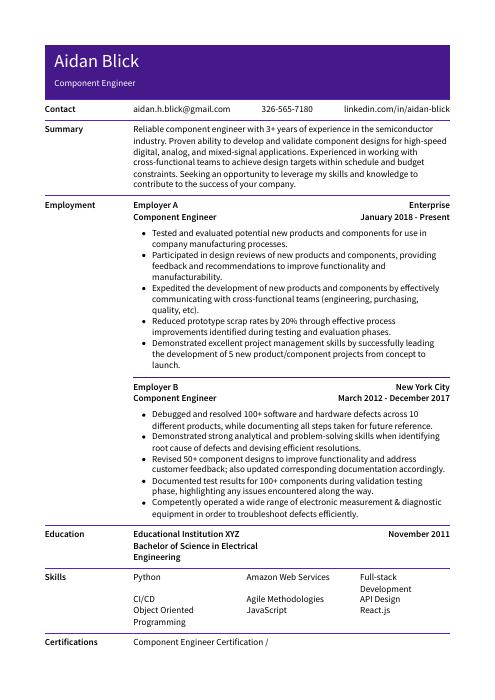 Pika
Pika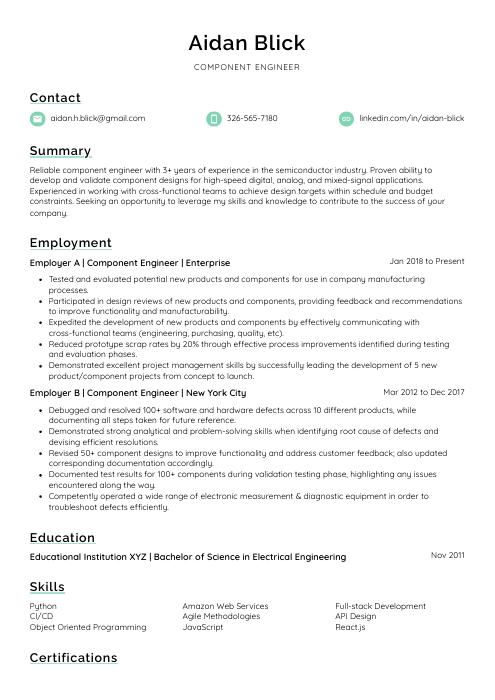 Lorikeet
Lorikeet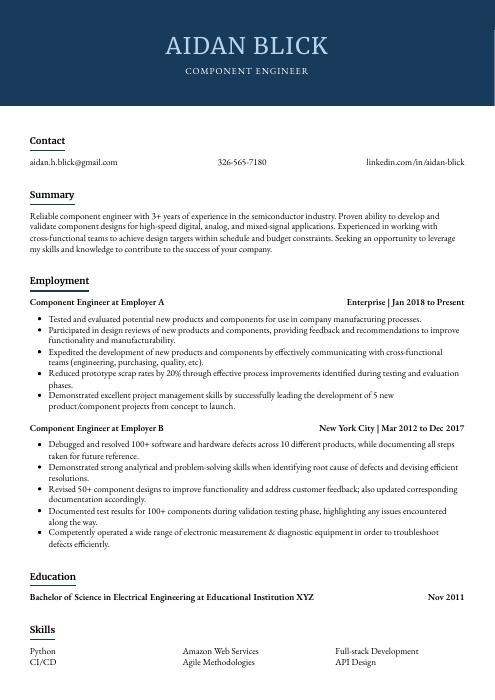 Bonobo
Bonobo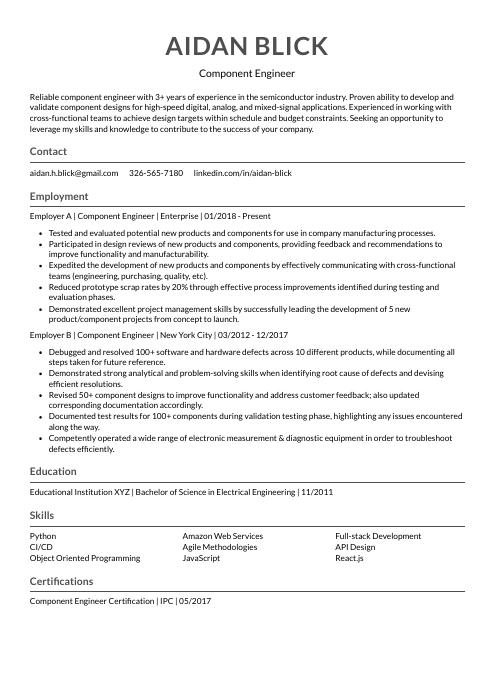 Indri
Indri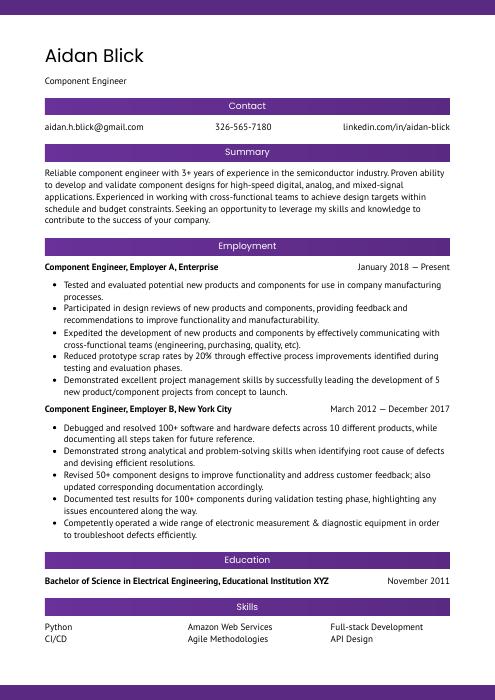 Jerboa
Jerboa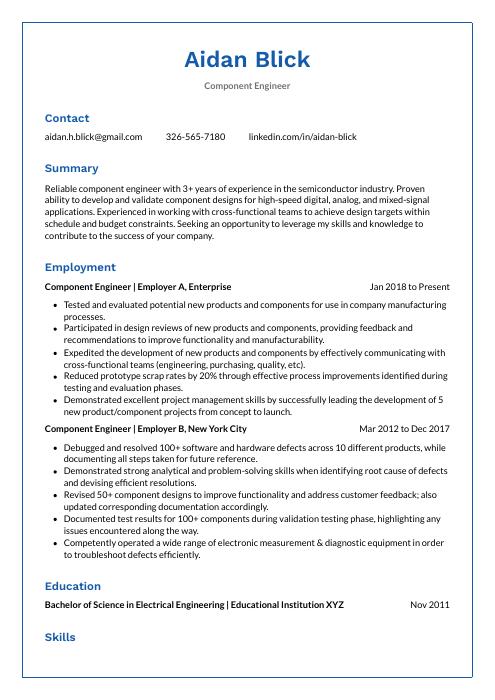 Markhor
Markhor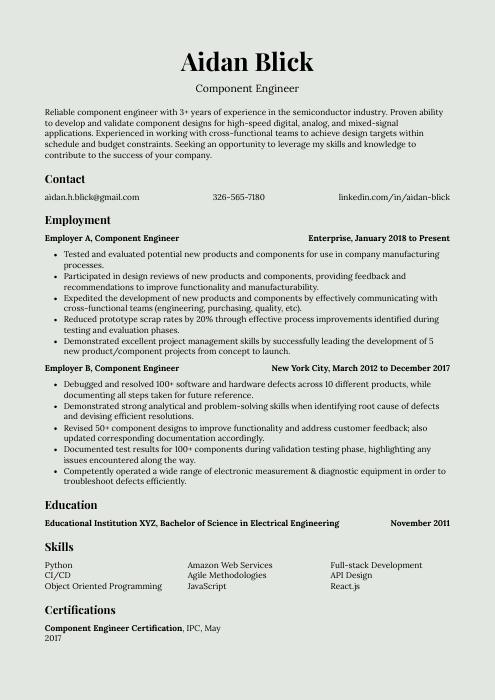 Saola
Saola Rezjumei
Rezjumei
